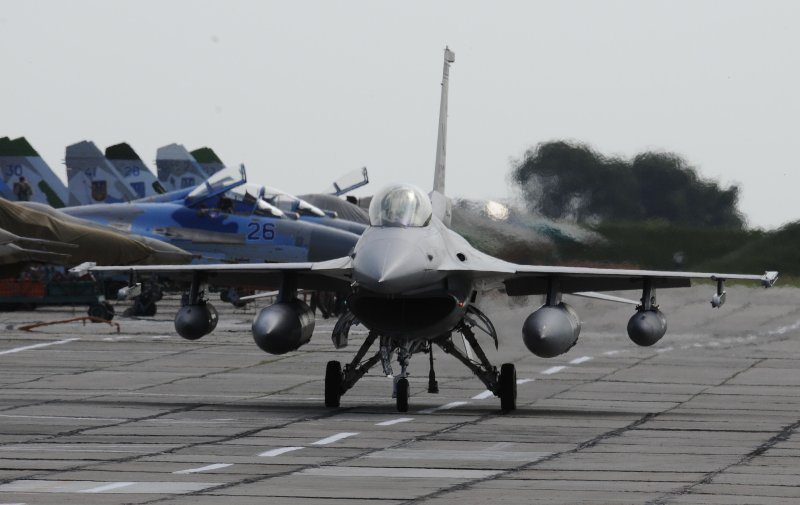After training six years with specially designed F-16 Fighting Falcons, Polish air force “Tigers” traveled half the world over in their first transatlantic voyage to Alaska to experience world-class training at RED FLAG-Alaska 12-2.
In only a few weeks, the Polish demonstrated a willingness to prove themselves as one of Europe’s front runners in modern air combat, seizing each opportunity to receive premier aerial combat training from their coalition partners.
Throughout the two-week exercise, the Polish emphasized the need to test the full capabilities of the F-16 aircraft, and to focus their efforts on evaluating the pilots’ training toward RF-A as well as ensuring their maintainers and munitions personnel kept the Tigers loaded and in the air.
Aerial combat training was conducted in the Joint Pacific Alaska Range Complex which offers a terrain useful for large-scale tactical integration but also includes the use of the three impact areas available for live bomb drops. This capability is rarely available in other areas where air space is shared with multiple nations and governing bodies.
“We have a lot of new tools, so one of the most important goals was to evaluate our weapon systems,” said Polish air force Lt. Col. Pawell Marcinkowski, 6th Fighter Squadron commander. “We had an opportunity to use [the] range to drop live weapons with a mixed load and were able to use different weapon configurations [even] with conformal fuel tanks. This is very unique for the F-16.”
CFTs offer a considerable amount of mission flexibility, said Marcinkowski because they are designed to increase aircraft weapons load and flying range. During RF-A, the Polish when carrying two CFTs could bring a weapons load consisting of four 2,000-pound bombs to combat.
The chance to drop live ordnance was a high priority for the Polish air force because of its benefit to testing weapons systems as well as assessing weapons integration. The opportunity also allowed the Polish pilots to drop live munitions from the Fighting Falcon for the first time.
“In Poland we are normally using training bombs … tiny bombs [which] look like toys,” said Polish Lt. Col. Krzysztof Pusz, Poznan Air Base, Poland, maintenance group deputy commander. “Here we had an opportunity to drop real bombs — various types of bombs. Six years after purchasing F-16s it was the first opportunity to use live weapons.”
“For the weapon system, we don’t want to go to combat [without] dropping bombs and [risk] not knowing if it works or not,” added Marcinkowski.
In Poland, much like the rest of Europe, training areas are limited as a result of minimal air space, especially live target areas. These kinds of aerial combat training areas are scarce and unlike anything currently found in Europe.
RF-A provides international and domestic military personnel with an opportunity to participate in an exercise using one of the largest training areas in the world. With 67,000 square miles of air space there is little the . Air Force and its coalition partners cannot achieve in its vastness.
Marcinkowski said the opportunity to use the JPARC could not be passed up. Aerial combat training accomplished elsewhere may not be so different when it comes to tactics and mission planning. However, the real difference lies in the availability of valuable air space – a luxury wherever found.
“Flying here using your airspace, which is huge [allowed us to] fly low level through mountains,” Marcinkowski said. “In Europe, we don’t have this opportunity because there are a lot of national parks. [The range] is very unique and it’s worked very well for us.”
Marcinkowski mentioned the importance of the maintenance section confirming that this iteration of RF-A has been a challenge for them as maintainers who had the challenge of keeping the eight F-16s operable each day of the exercise. They worked long hours to ensure aircraft were available for pilots the next morning.
“[Maintenance members] can work hard, they can work long,” said Pusz. “This is our task, to have aircraft ready for pilots and we have done that. Experience [gained] from smaller deployments like Tactical Leadership Program, Freezing Flag, Tiger Meet and Loyal Arrow culminated and has benefited us in preparing for RED FLAG-Alaska.”
From preparation to the conclusion of the exercise, the Polish made sure they approached each training opportunity with a positive attitude showing they were more than willing to learn from their allies Pusz added. It was a group effort in maintaining such a high operations tempo, and while there is much to improve, at the end of the exercise the Polish confirmed they are mission ready.
The Polish air force looked to RF-A as an ideal opportunity to challenge military personnel and their latest additions in military assets. And with help from the 18th Aggressor Squadron and other participants from the exercise the Polish walked away with a snapshot of how far they’ve come as an aerial power since announcing the purchase of 48 F-16s.
It is uncertain when the Polish air force will participate in another RF-A. However, Polish leadership has expressed satisfaction with training and the evaluation of the F-16.
“We would like to come here every year,” Pusz said. “It’s very, very important, especially for pilots, to fly in as close [to] real conflict or war scenarios and RED FLAG-Alaska has given us that opportunity.”









